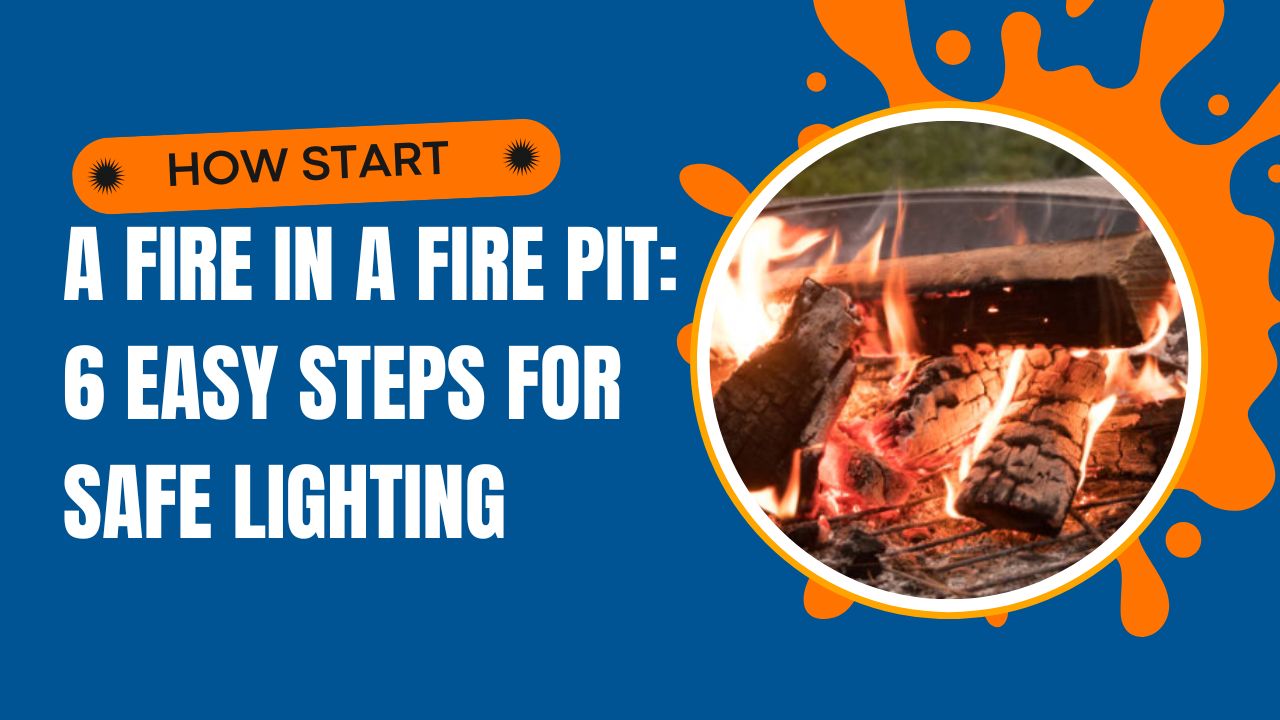
How to Start a Fire in a Fire Pit: 6 Easy Steps for Safe Lighting
Are you struggling to get your fire pit started or worried about doing it safely? Master these 6 proven steps for safe fire starting that work every time – from proper preparation to sustained burning that creates magical outdoor experiences. In Australia's bushfire-prone environment, knowing how to start fires properly isn't just convenient; it's critical for community safety.
Fire Pit Mastery: The Art of Safe Fire Starting in Australia
Fire Pit Starting: Beyond Just Lighting a Match
Well-started fires provide immense satisfaction through crackling flames, radiant warmth, and mesmerising displays that create unforgettable outdoor entertainment experiences for families and friends.
However, successful fire starting requires understanding proper techniques, safety protocols, and Australian fire conditions that transform basic lighting into comprehensive fire management skills.
Fire Pit Safety: Importance in Australian Conditions
Australian bushfire environment demands heightened awareness and precise fire-starting techniques that prevent accidents, ensure regulatory compliance, and protect communities from devastating fire spread.
Proper fire starting eliminates common mistakes that can cause dangerous situations, smoke problems, or fire spread, which could trigger emergency responses or legal consequences.
Fire Pit Science: The Fire Triangle Fundamentals
Fire Pit Combustion: Fuel, Oxygen, and Heat
Understanding the basics of combustion helps create successful fires every time. Fuel provides burning material, oxygen enables combustion, and heat initiates and sustains the burning process.
Fire pit designs optimise these elements through proper ventilation, fuel placement, and heat management, creating ideal conditions for reliable ignition and sustained burning.
Fire Pit Setup Optimisation ensures all three elements work together effectively, preventing common failures that frustrate beginners and create safety hazards.

Fire Pit Starting Guide: 6 Easy Steps for Perfect Fires
Fire Pit Step 1: Prepare Your Fire Pit and Surroundings
Fire Pit Cleanliness requires removing old ash and debris that could interfere with airflow or create unpredictable burning conditions during attempts to light the fire.
Fire Pit Non-Combustible Base verification ensures placement on safe surfaces, including concrete, pavers, or bare earth, that eliminate ignition risks from heat transfer.
Fire pit 3-metre clearance compliance ensures safe distances from combustible materials, including houses, fences, plants, furniture, and stored materials that could ignite from radiant heat or ember contact.
Fire Pit Emergency Tools, including connected water hoses, filled buckets, and shovels, must be readily accessible for immediate fire suppression during both routine and emergencies.
Fire Pit Step 2: Choose the Right Fuel Selection
Fire Pit Kindling Materials include dry leaves, paper, small twigs, and natural firelighters that ignite easily and provide initial heat for larger fuel ignition.
Fire Pit Smaller Fuel encompasses finger-sized branches and split wood that bridge the gap between kindling and main logs while maintaining steady heat buildup.
Fire Pit Main Fuel features dry, seasoned hardwoods, including gum, ironbark, and red gum, that provide sustained burning with minimal smoke production when properly prepared.
Australian Fire Pit Timber should be locally sourced and properly seasoned to reduce smoke, comply with environmental regulations, and support sustainable forestry practices.
Fire Pit Prohibited Materials include treated timber, painted wood, plastics, household rubbish, accelerants like petrol or kerosene, and green or damp wood that create toxic emissions or dangerous combustion.
Fire Pit Step 3: Build Your Fire Lay Structure
The Fire Pit Teepee Method creates classic arrangements with excellent airflow, enabling rapid ignition and reliable flame development for both beginners and experienced users.
The fire Pit Log Cabin Method provides stable, crosshatch arrangements ideal for longer burns once established, offering sustained heat with minimal maintenance requirements.
Fire Pit Airflow Management, through proper arrangement, allows for oxygen circulation that feeds combustion while preventing smothering, which can cause fire failure or excessive smoke.
Fire Pit Step 4: Add Kindling and Firelighters Safely
Fire Pit Kindling Placement involves loosely arranging materials at the centre to allow air circulation while providing adequate fuel surface for ignition spread.
Fire Pit Safe Firelighters include natural firestarters and paper balls that ignite reliably without toxic emissions or dangerous flare-ups that threaten safety.
Fire Pit Accelerant Prohibition eliminates flammable liquids that create dangerous flash fires, toxic emissions, and unpredictable burning that threaten user safety and equipment.

Fire Pit Step 5: Light the Fire Safely and Effectively
Fire Pit Safe Ignition uses long-handled lighters or matches that maintain safe distances from flames while providing reliable ignition sources for kindling materials.
Fire Pit Bottom Lighting allows flames to work upward naturally, following combustion principles that create self-sustaining fires through proper heat transfer and oxygen flow.
The Fire Pit Patient Approach enables kindling to catch properly, rather than rushing the process, which often results in fire failure and repeated lighting attempts.
Fire Pit Step 6: Nurture and Manage Fire Development
Fire Pit Gradual Fuel Addition begins with smaller pieces and progressively adds larger logs as the fire's strength develops, maintaining a steady heat without overwhelming combustion.
Fire Pit Airflow Maintenance prevents smothering by carefully placing wood to preserve oxygen circulation, which is essential for sustained burning and heat production.
Fire Pit Constant Supervision ensures alert adult presence throughout the operation who can respond immediately to changing conditions, safety concerns, or emergencies.
Fire Pit Spark Screen Usage ensures ember production remains within safe boundaries, allowing for proper ventilation and heat distribution during wood-burning operations.
Fire Pit Australian Safety: Critical Compliance Reminders
Fire Pit Regulatory Verification
Fire Pit Total Fire Ban Checking represents the essential first step before lighting any fire, as TFB declarations override all other considerations and carry severe penalties.
Fire Pit Fire Danger Period Awareness requires understanding the current Fire Danger Period (FDP) status, which may restrict fire pit use or require special permits from local fire authorities.
Fire Pit Wind Condition Assessment prohibits fire lighting during windy conditions when ember spread becomes uncontrollable and creates unacceptable community risks.
Fire Pit Local Compliance
Fire Pit Council By-Law Verification ensures compliance with specific local regulations that may be stricter than state requirements regarding residential open fires.
Fire Pit Neighbour Consideration encompasses awareness of smoke impact and timing that respects community relationships while complying with nuisance regulations.
Fire Pit Equipment and Accessories
Quality fire-starting tools, including long lighters, natural firelighters, and proper fuel storage, enhance safety while ensuring reliable ignition success every time.
Professional fire pit accessories such as spark screens, fireproof gloves, and dedicated ash removal tools support safe operation while protecting equipment investments.
Fire Pit Environmental Responsibility
Responsible fuel sourcing supports sustainable forestry, while proper burning techniques minimise environmental impact through complete combustion and reduced emissions.
Local ecosystem protection requires understanding the impacts of native fires and choosing burning practices that respect natural environments and wildlife habitats.
Conclusion: Fire Pit Success Through Proper Technique
Following these 6 proven steps ensures safe, efficient, and enjoyable fire pit experiences that create lasting memories while protecting community safety and environmental health.
Responsible fire management through proper starting techniques represents crucial skills for Australian fire pit owners who prioritise safety, compliance, and environmental stewardship.
Master these techniques to ignite fun experiences rather than dangerous situations, ensuring your fire pit brings joy and warmth while maintaining the highest safety standards for Australia's unique bushfire environment.


